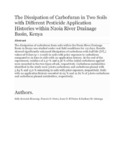| dc.contributor.author | Kimosop, Selly Jemutai | |
| dc.contributor.author | Orata, Francis O. | |
| dc.contributor.author | K’Owino, Isaac O | |
| dc.contributor.author | Getenga, Zachary M. | |
| dc.date.accessioned | 2021-06-09T07:09:28Z | |
| dc.date.available | 2021-06-09T07:09:28Z | |
| dc.date.issued | 2014-02-28 | |
| dc.identifier.uri | https://doi.org/10.1007/S00128-014-1234-5 | |
| dc.identifier.uri | https://link.springer.com/article/10.1007/s00128-014-1234-5 | |
| dc.identifier.uri | http://r-library.mmust.ac.ke/123456789/1652 | |
| dc.description.abstract | The dissipation of carbofuran from soils within the Nzoia River Drainage Basin in Kenya was studied under real field conditions for 112 days. Results showed significantly enhanced dissipation of carbofuran with half life (DT50) values of 8 days (p = 0.038) in soils with prior exposure to carbofuran compared to 19 days in soils with no application history. At the end of the experiment, residues of 2.57 % and 9.36 % of the initial carbofuran applied were recorded in the two types of soil, respectively. Carbofuran metabolites identified in the study were 3-keto carbofuran and carbofuran phenol with 5.84 % and 15.0 % remaining in soils with prior exposure, respectively. Soils with no application history recorded 16.05 % and 12.82 % of 3-keto carbofuran and carbofuran phenol metabolites, respectively. | en_US |
| dc.language.iso | en | en_US |
| dc.publisher | Bulletin of Environmental Contamination and Toxicology | en_US |
| dc.subject | Dissipation, Carbofuran, Soils, Pesticide, Application, Histories | en_US |
| dc.title | The Dissipation of Carbofuran in Two Soils with Different Pesticide Application Histories within Nzoia River Drainage Basin, Kenya | en_US |
| dc.type | Article | en_US |

